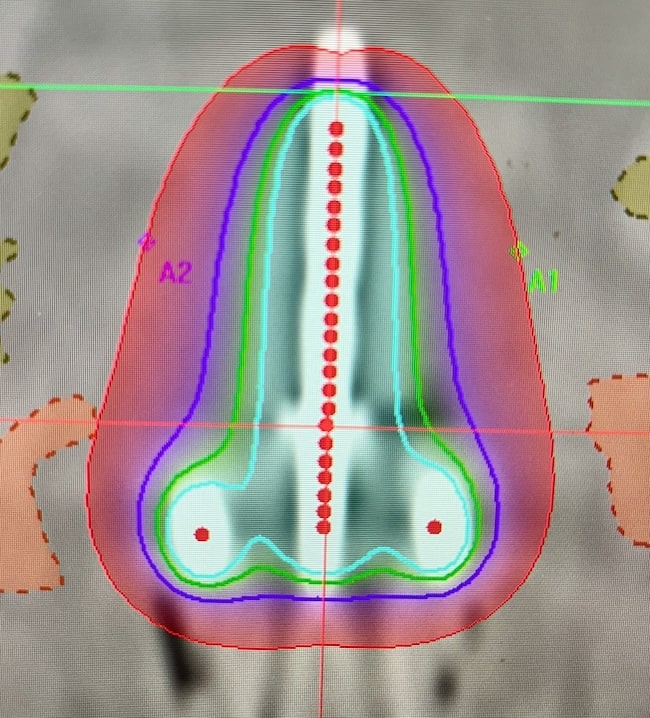Brakhiterapi merupakan komponen penting dalam penatalaksanaan kanker serviks. Pemberian brakhiterapi bertujuan sebagai boost (tambahan dosis) pada tumor gross, sehingga mampu meningkatkan kontrol perjalanan penyakit dan kesintasan pasien. Brakhiterapi merupakan bagian dari radioterapi yang menempatkan sumber radioaktif pada jarak sangat dekat dengan tumor.[1-6]
Tujuan Brakhiterapi pada Kanker Serviks
Pemberian radiasi eksternal yang dilanjutkan dengan brakhiterapi merupakan terapi standar kanker serviks, terutama pada kasus lanjut lokal. Tujuan radioterapi eksternal adalah mencakupi dosis radiasi pada tumor primer dan memberikan ekstensi radiasi hingga ke parametrium dan KGB regional. Sementara itu, tujuan brakhiterapi untuk mencapai eskalasi dosis pada tumor lokal.[7]
Berikut beberapa tujuan brakhiterapi pada kanker serviks:
- Brakhiterapi tunggal tanpa radiasi eksternal tidak rutin digunakan, kecuali ada justifikasi dokter ahli onkologi radiasi.[7]
- Brakhiterapi diberikan setelah radiasi eksternal, yang memiliki dua peran utama, yaitu peran definitif dan peran adjuvan. Termasuk peran adjuvan pada kanker serviks insidental yang sering ditemukan pada stadium amat dini.[3,7-10]
- Brakhiterapi sebagai terapi preoperatif histerektomi[11,12]
- Brakhiterapi sebagai terapi salvage bila terjadi kekambuhan kanker serviks pasca terapi definitif sebelumnya.[7,13-15]
Peran Definitif Brakhiterapi Pasca Radiasi Eksternal
Radiasi definitif kuratif untuk kanker serviks diberikan pada kasus-kasus yang unresectable atau inoperable, sehingga sering juga disebut radiasi pada uterus intak. Radiasi definitif kuratif tersebut diberikan dalam bentuk radiasi eksternal yang dilanjutkan dengan brakhiterapi.[7]
Radiasi eksternal standard biasanya diberikan pada kanker serviks stadium lanjut (stadium IB3, IIA2, IIB, hingga IVA), dengan rentang dosis 45‒50 Gy (25 x 1,8 Gy atau 25 x 2 Gy). Selanjutnya, kelenjar getah bening (KGB) gross yang tidak direseksi dapat diberikan boost radiasi eksternal dengan dosis 10‒15 Gy.[7,10]
Tujuan Brakhiterapi Pasca Radiasi Eksternal
Brakhiterapi berperan untuk memberikan tambahan atau boost dosis radiasi pada tumor primer. Ekstensi yang diberikan sebesar 30‒40 Gy, baik dengan teknik 3 dimensi maupun 2 dimensi (peresepan ke titik A). Total dosis titik A sebesar 80 Gy diberikan untuk tumor berukuran kecil, sedangkan untuk tumor berukuran besar diberikan total ≥85 Gy. Untuk tumor yang berukuran sangat kecil (IA1 atau IA2), dapat dipertimbangkan pemberian dosis 75‒80 Gy.[16]
Tujuan utama pemberian brakhiterapi adalah tercapainya total dosis EQD2 (equivalent dose in 2 Gy - dosis setara total dosis pada radiasi konvensional dengan pemberian per fraksi 2 Gy) dari radiasi eksternal dan brakhiterapi sebesar minimal 80‒85 Gy.[16]
Dosis dan Jenis Brakhiterapi Pasca Radiasi Eksternal
Brakhiterapi dapat diberikan dalam beragam pilihan fraksi. Umumnya, brakhiterapi diberikan dalam 5 fraksi, dengan dosis per fraksi sebesar 5,5 Gy untuk stadium dini atau 6 Gy untuk tumor besar dengan respons kurang baik. Dosis 30 Gy dalam 5 fraksi dengan high dose-rate (HDR) dianggap ekuivalen dengan 40 Gy ke titik A, dengan menggunakan brakhiterapi low dose-rate (LDR). Pilihan dosis lain yang dianggap setara dan relatif sering digunakan di Indonesia adalah 4 fraksi dengan 7 Gy per fraksi.[7]
Penentuan jenis brakhiterapi dilakukan berdasarkan respons kanker terhadap radiasi eksternal sebelum brakhiterapi dimulai. Jenis brakhiterapi dibagi menjadi beberapa kategori berikut:
- Kategori I: tanpa/dengan residu gross yang terbatas pada serviks dan jaringan paraservikal
- Kategori II: terdapat residu gross yang terbatas pada serviks dan parametrium medial dan/atau vagina proksimal
- Kategori III: terdapat residu gross yang berekstensi hingga parametrium distal dan/atau vagina distal
- Kategori IV: terdapat residu gross yang melibatkan organ [17]
Pasien dengan kasus yang termasuk ke kategori I cukup membutuhkan brakhiterapi intrakaviter saja. Kasus kategori II membutuhkan brakhiterapi kombinasi intrakaviter dan interstisial. Sementara, kasus kategori III dan IV membutuhkan brakhiterapi interstisial.[17-20]
Penelitian Keunggulan Brakhiterapi Pasca Radiasi Eksternal
Penelitian retrospektif oleh Karlsson et al, yang melibatkan 220 pasien kanker serviks stadium I‒IV, membandingkan pasien yang mendapatkan radiasi eksternal dilanjutkan brakhiterapi 3‒5 fraksi (dosis per fraksi 6 Gy) dengan pasien radiasi eksternal yang mendapatkan dosis boost radiasi eksternal (total dosis 64‒72 Gy) sebagai pengganti brakhiterapi.[8]
Hasil penelitian mendapatkan angka remisi penuh pada kelompok brakhiterapi sebesar 92,5%, sedangkan kelompok boost radiasi sebesar 73,3%. Angka kesintasan spesifik 5 tahun sebesar 68,5% pada kelompok brakhiterapi, yang lebih baik dibandingkan 35,4% pada kelompok boost. Selain itu, angka rekurensi pada kelompok brakhiterapi lebih rendah (31,3%) daripada kelompok boost (37,2%). Semua angka kesintasan tersebut berbeda bermakna secara statistik.[8]
Waktu total keseluruhan tata laksana kanker serviks mulai sejak radiasi fraksi pertama radiasi eksternal hingga akhir fraksi terakhir brakhiterapi (overall treatment time / OTT) telah lama diketahui sebagai salah satu faktor penting yang berkaitan dengan luaran terapi. Semakin panjang OTT (>8 minggu) maka semakin buruk luaran terapi yang dihasilkan.[8,21]
Penelitian di atas mengemukakan bahwa brakhiterapi ternyata mampu mengompensasi pemanjangan OTT. Walaupun pasien mengalami OTT >8 minggu, luaran pasien dengan brakhiterapi tersebut masih lebih baik daripada pasien yang mendapatkan terapi <8 minggu tetapi tidak diberikan brakhiterapi.[8]
Peran Brakhiterapi Adjuvan Setelah Histerektomi
Brakhiterapi vaginal untuk kanker serviks pasca histerektomi biasanya diberikan sebagai tambahan setelah radiasi eksternal. Belum ada konsensus yang jelas mengenai indikasi ini, bahkan pedoman National Comprehensive Cancer (NCCN) tidak merekomendasikan brakhiterapi vaginal rutin diberikan pasca histerektomi.[7]
Brakhiterapi tunggul vagina (vaginal cuff) harus dipertimbangkan pada histerektomi yang tidak radikal. Brakhiterapi ini juga dianjurkan untuk pasien dengan faktor risiko patologis tertentu, di antaranya close margin atau positif, tumor besar atau invasif dalam, keterlibatan parametrium atau vagina, dan lymphovascular space invasion (LVSI) yang ekstensif.[7]
Kondisi Penyulit dalam Pemberian Brakhiterapi Adjuvan
Hal yang perlu menjadi pertimbangan saat melakukan brakhiterapi adalah ⅓ proksimal vagina yang biasanya direseksi saat histerektomi radikal, sehingga membatasi akses transvaginal ke parametrium dan jaringan pelvis dalam. Kondisi ini dapat menyebabkan pemberian brakhiterapi tanpa radiasi eksternal tidak dapat mencapai margin positif yang terletak pada parametrium lateral, atau pada pelvis dekat dengan bidang diseksi kandung kemih atau rektum.[22]
Penelitian Keunggulan Brakhiterapi Adjuvan Setelah Histerektomi
Dalam studi terhadap 225 pasien, Yu et al melaporkan perbedaan antara 99 pasien kanker serviks pascaoperasi yang mendapatkan brakhiterapi vaginal dengan 126 pasien tanpa brakhiterapi tetapi mendapatkan terapi radiasi eksternal. Grup brakhiterapi memiliki locoregional recurrence free survival (LRRFS) 5 tahun yang lebih superior daripada grup radiasi eksternal (87,7% vs 72,5%, p=0,004).[9]
Namun, grup brakhiterapi tidak menunjukkan keunggulan angka ketahanan hidup daripada grup radiasi eksternal (78,4% vs 75,3%, p=0,055). Dalam analisis multivariat, didapatkan faktor prognostik untuk LRRFS 5 tahun terdiri dari brakhiterapi, jenis patologi, faktor risiko tinggi, durasi radioterapi, dan transfusi.[3]
Dalam analisis terstratifikasi, brakhiterapi yang diberikan pada kasus dengan kriteria Sedlis positif (kriteria yang menjadi dasar pemberian radiasi adjuvan) menunjukkan LRRFS yang lebih superior (p=0,017).[3]
Peran Brakhiterapi pada Kanker Serviks Invasif Insidental
Kanker serviks invasif insidentil biasanya terjadi setelah histerektomi ekstrafasial. Pada kasus ini, tindakan histerektomi yang di bawah standard untuk kanker serviks (yakni histerektomi radikal) perlu dievaluasi ulang apakah perlu tambahan radiasi pelvis, yang biasanya dikombinasikan dengan brakhiterapi vaginal.[23]
Belum ada data jelas yang tersedia untuk memandu terapi adjuvan yang tepat untuk pasien-pasien ini. Kebanyakan kanker serviks invasif didiagnosis pada stadium dini (stadium IA1 dengan LVSI negatif), sehingga pasien seringkali direkomendasikan untuk diobservasi saja.[24]
Namun demikian, brakhiterapi dinilai mempunyai peran sebagai tambahan setelah pemberian radiasi eksternal dengan kemoterapi konkuren pada kasus-kasus kanker serviks stadium IA1 dengan LVSI, stadium IA2/IB, serta dengan tepi sayatan positif atau residu gross.[24]
Peran Brakhiterapi Preoperatif Sebelum Histerektomi
Berdasarkan pedoman European Society of Gynaecological Oncology, European Society for Therapeutic Radiology and Oncology, dan European Society of Pathology (ESGO/ESTRO/ESP), brakhiterapi preoperatif dapat dilakukan sebelum histerektomi pada pasien dengan kanker serviks stadium dini. Namun, brakhiterapi preoperatif hingga saat ini tidak diberikan secara rutin dan belum menjadi prosedur standard.[25]
Penelitian Keunggulan Brakhiterapi Preoperatif Sebelum Histerektomi
Studi oleh Escande et al mengevaluasi pasien kanker serviks stadium dini antara tahun 2004‒2013, yang mendapatkan terapi pulsed dose rate brachytherapy preoperatif sebelum histerektomi. Dari 77 pasien, respons komplit secara histologi ditemukan pada 54 pasien (70,1%), sedangkan residu tumor berukuran ≥1 cm hanya ditemukan pada 4 pasien. Angka kesintasan bebas penyakit selama 5 tahun sebesar 84,4%, dan hanya terdapat 1 kasus rekurensi yang muncul.[11]
Meta analisis oleh Vieira-Serna berhasil mengumpulkan 10 uji nonacak, tetapi hanya 3 uji acak terkontrol yang meneliti penggunaan brakhiterapi sebelum histerektomi. Dari 4 parameter yang diamati, pemberian brakhiterapi preoperatif secara statistik mampu mereduksi angka margin reseksi yang positif, respons komplit dalam laporan patologi, dan meningkatkan angka kesintasan 5 tahun. Namun, hasil analisis ini belum cukup signifikan secara statistik untuk mempengaruhi angka rekurensi.[12]
Peran Brakhiterapi Salvage pada Kasus Rekurensi
Peran salvage merujuk pada tata laksana untuk kasus keganasan yang mengalami rekurensi. Brakhiterapi merupakan salah satu pilihan tata laksana salvage pada kanker serviks yang rekuren, selain stereotactic body radiation therapy (SBRT). Brakhiterapi dapat diberikan dalam bentuk interstisial dan implantasi seed.[13]
Penelitian Keunggulan Brakhiterapi Salvage pada Kasus Rekurensi
Seri laporan oleh Kozai et al melaporkan angka overall survival, kontrol lokal, dan kesintasan bebas progresi 3 tahun dari 36 pasien dengan rekurensi lokal setelah histerektomi sebesar 100%, 82,8%, dan 76,8%. Studi ini menyimpulkan bahwa brakhiterapi high dose rate (HDR) intrakaviter merupakan modalitas yang efektif untuk rekurensi kanker serviks pada tunggul vagina (vaginal stump).[14]
Ren et al di tahun 2022 juga melaporkan penggunaan brakhiterapi interstisial image-guided untuk kanker serviks setelah pemberian terapi radiasi sebelumnya. Reiradiasi atau radiasi ulang pada kasus rekurensi ini diberikan baik hanya dengan brakhiterapi saja ataupun sebagai kombinasi brakhiterapi dan radiasi eksterna.[15]
Dosis reiradiasi diberikan dalam median EQD2 sebesar 64,2 Gy (31,3‒95,1 Gy). Peneliti mendapatkan angka respons penuh setelah reiradiasi sebesar 56,5%. Sebanyak 27,1% pasien masih bertahan hidup 4 tahun setelah kekambuhan dan pemberian reiradiasi.[15]
Tantangan Brakhiterapi pada Kanker Serviks
Terlepas dari begitu banyaknya peran dan manfaat brakhiterapi dalam penatalaksanaan kanker serviks, pengembangan fasilitas pelayanan brakhiterapi membutuhkan biaya tersendiri yang tidak murah. Karena bersifat tindakan/prosedural, brakhiterapi membutuhkan pelatihan staf nonmedik secara khusus. Selain itu, tindakan brakhiterapi juga membutuhkan persiapan sebelum, koordinasi saat pelaksanaan (misalnya dengan dokter spesialis anestesi), dan membutuhkan pemantauan pasca tindakan.[26]
Kesimpulan
Brakhiterapi merupakan bentuk terapi radiasi yang efektif, yang bersamaan dengan radiasi eksternal menjadi standard dalam penatalaksanaan kanker serviks. Brakhiterapi sangat efektif untuk meningkatkan kontrol lokal karena mampu memberikan eskalasi dosis yang sangat baik.
Brakhiterapi memiliki peran adjuvant setelah histerektomi total dan peran definitif yang sudah terbukti lewat berbagai uji klinis acak. Peran salvage, peran preoperatif, serta peran pada kasus-kasus kanker serviks insidentil masih memerlukan uji klinis lebih lanjut. Terdapat berbagai macam aplikator brakhiterapi dan teknik pemberian brakhiterapi (2D atau 3D) yang dapat disesuaikan dengan berbagai keperluan kategori kasus yang menjadi indikasi pemberian brakhiterapi.














